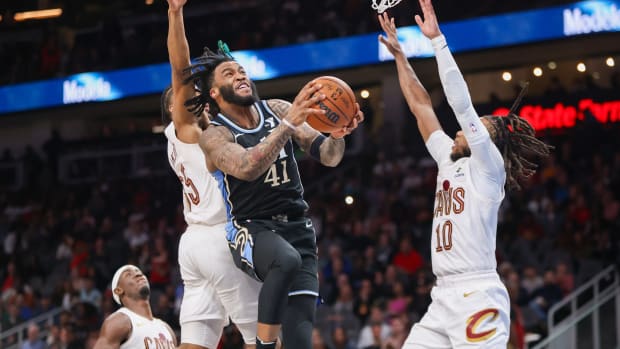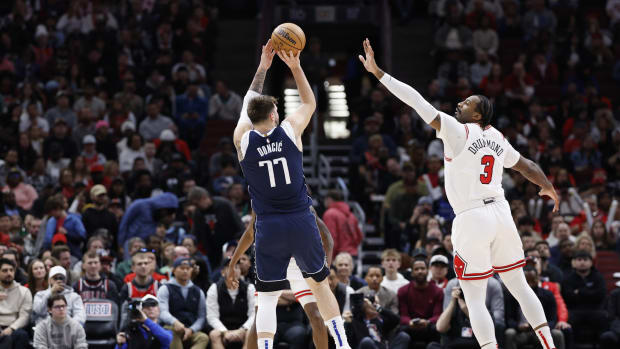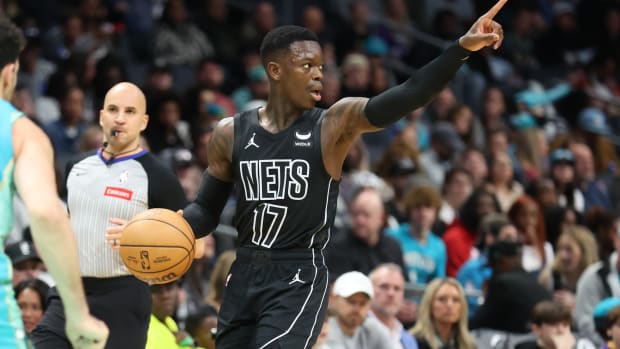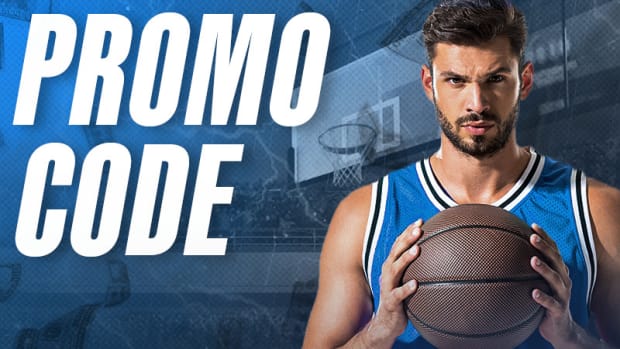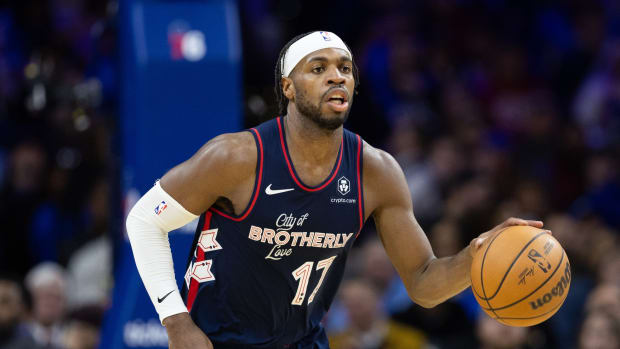The Process Is Over: Ben Simmons and the 76ers Have Arrived
This story appears in the December 4, 2017, issue of SPORTS ILLUSTRATED. To subscribe, click here.
Three nights before his NBA unveiling, Ben Simmons crept through the dank and decrepit corridors of Eastern State Penitentiary, black baseball cap pulled over his eyes. Eastern State, a Gothic prison two miles north of Simmons’s high-rise apartment in Center City, was once home to Al Capone and Slick Willie Sutton, but now the crumbling brick castle is transformed every fall into Philadelphia’s most harrowing haunted house. Simmons claims to love scary movies, but friends wonder if he actually watches them, describing him purely as a South Park devotee. “You go first,” Simmons instructed his older brother Sean Tribe. “You’re 6'10",” Tribe muttered. “Why should I go first?”
They huddled together, sidestepping ax murderers and deranged doctors in the darkened hallways. Near midnight, Simmons peered into a vaulted cell, where a possessed inmate with streaked makeup stared back through the metal bars. Between dying moans, the jailbird in the jumpsuit fell silent, momentarily breaking character. “Oh, s---!” he shrieked, loud enough for anyone on the cell block to hear. “It’s Ben Simmons!” Suddenly, the 76ers’ stretchy prodigy was being chased by chain saws and scythes, every struggling actor eager to impress as well as petrify.
For five years, Simmons was part phenom, part phantom, a supernatural specter who supposedly fused the speed and vision of LeBron James with the length and agility of Kevin Durant. He came from the sands of Australia but existed mainly in high school showcases and YouTube reels, hype factories that inflate teenagers and inflame imaginations. Simmons spent one season at LSU (notable only for the critically acclaimed documentary chronicling it) and three practices with the Sixers before breaking the fifth metatarsal in his right foot. He languished in that Center City apartment, playing games on his desktop while simultaneously balancing FaceTime conversations on his iPad and iPhone, an impressive feat of millennial multitasking.
Just 21, Simmons has been waiting almost a quarter of his life to play in the NBA. At 17, perched on the side of a high school gym in Las Vegas after a session at the LeBron James Skills Academy, he felt a meaty palm on his shoulder. “Tomorrow morning,” James told him, “6:30.” Simmons was dressed by four. As he did pull-ups in the fitness center at the Wynn hotel alongside James and Dwyane Wade, he kept FaceTime on his phone, so his best friend from home could watch. Simmons grew up wearing Wade’s Converse kicks, buying pairs in red, white and black. He studied James’s highlights on his iPad during class. He came of age with the Heat’s Big Three, who handed the rock to their 6'8", 250-pound kingpin and called it small ball.
“You have an opportunity,” James told Simmons early on, “to be better than me. But you can’t skip steps. You have to do the work.” Those words helped sustain him when he stumbled at LSU and helped fuel him as he rehabbed in Philadelphia. “Is this really going to happen?” he asked himself. He knew, even if others wavered, that it would. Because LeBron said so, and for a prospect of Simmons’s vintage, no endorsement means more. “Part of his greatness,” Simmons says, “is that he wants others to be just as great.”
In September, the 76ers gathered at their headquarters for pickup games. Many players admit they were scouting Simmons: point guard or power forward, phenom or phantom. It had been a year since they’d seen him do anything but shoot on a side basket. Justin Anderson, Philly’s 6'6", 230‑pound third-year wing, matched up against Simmons. “The strength, the pace, the patience, it was shocking,” Anderson says. “He could post you up and move you out, but he could also jump over you, and he was throwing lobs from half-court. I told him afterwards, ‘There’s only one other guard who makes me feel small, and that’s LeBron.’”
Much ink has been spilled, and time wasted, identifying the heir to Michael Jordan. The search for James’s successor will be just as tiresome and fruitless. Ben Simmons is not the next LeBron James. But he may be the first star to fill the lane LeBron opened.
On the first extended road trip of his career, Simmons sits in the back booth of a restaurant in downtown Sacramento, sipping his second hot chocolate. A fly buzzes by his head and he catches it with a wave of his right hand. Simmons leads all rookies in points (18.7), rebounds (9.5), assists (7.2) and steals (2.1)—phenom, to be sure—his grab-and-go fast breaks already a signature. He glides with a grace that belies his height, firing crosscourt with either hand and from any angle, the ball sometimes appearing to jet out of his hip. His Australian accent is evident only when he says certain words. Pass is one of them.
Simmons occasionally acts his age, expressing an abiding affection for Sour Patch Kids, milkshakes and exotic pets, such as his French bulldog, Flash. He grapples with colorways for his size-16 Nike Hyperdunks, curious if white makes him look quicker, as a 76ers trainer insists. But more often Simmons is understated and earnest, a veteran of the limelight if not the league. “What’s the weirdest thing about watching me?” he asks Sean after games, careful not to say “the best thing” or “the coolest thing.” The night before, in a win at Utah, he put up 16 points, 13 rebounds, six assists, three blocks and three steals, but “the weirdest thing” was an interception of Ricky Rubio he turned into a dunk over Thabo Sefolosha.
“I watch all my highlights,” Simmons says. “I should have jumped into Sefolosha there and drawn contact.” He has already reviewed pick-and-rolls with coaches (“Utah was going under the screen, but even though I hit shots, I kept hesitating”) and switches with teammates. On a guard-guard screen, the Jazz flared out the screener and J.J. Redick shouted “Red,” meaning that Simmons should switch, but he stayed with his man. At the ensuing timeout, Simmons told Redick he called the Red late. “Ben,” Redick replied. “I know when I call the Red late. I didn’t call the Red late. But it’s not about who’s right or wrong. It’s about making sure we don’t f--- it up next time.”
This is how you know the Process is over. After four years of self-inflicted losing streaks and lottery picks, the 76ers are quibbling about the exact timing of their switches, the kind of minutiae that consumes winners. “I don’t look at it as a process anymore,” Simmons says. “Now it’s just time to play.” Trust the Talent: Snipers such as Redick and Robert Covington spread around Simmons and Joel Embiid, the most captivating duo since Durant and Russell Westbrook were backpacking in Oklahoma City.
The Sixers are 12–8, but the keys to their long-term prosperity are Embiid’s health and Simmons’s handle, province of God and Brett Brown. After Philadelphia drafted Simmons first in 2016, the Sixers’ coach pored over video from LSU, studying the blue chipper’s body language. Tim Quarterman was the Tigers’ point guard, and a good one, with Simmons a playmaking power forward and secondary ballhandler. But whenever the opposing team made a basket, Brown noticed that Simmons would reflexively retreat to accept the inbounds pass, regularly bumping into Quarterman. “Awkward,” Brown thought.
Long before he took over the 76ers, Brown was a point guard for Boston University. His 13-year-old son, Sam, is a point guard for Philly Triple Threat. He knows a floor general when he sees one. Even though Simmons stood a foot taller than Isaiah Thomas, Brown recognized the skill and instinct. He called Simmons’s father. “David,” he said, “I think he’s a point guard. Has he ever done that before?”
Brown didn’t have to look very hard for the phone number. He coached David Simmons from 1989–93 with the Melbourne Tigers of the National Basketball League. David only started playing basketball as an underclassman at South Bronx High. With sharp elbows and skinned knees, he eventually turned himself into Australia’s Charles Oakley, a 6'9" power forward who once broke an opponent’s arm setting a screen. David’s ferocity on the boards compensated for his limitations as a passer, shooter and ballhandler. “I wanted Ben to have everything I didn’t,” he says.
Brown met Ben when he was a baby, already dribbling with a pacifier in his mouth. David played him alongside teenagers, and later grown men, fearing shortsighted coaches might maroon him on the low block because he was taller than his peers. “You’re not a center,” lectured Ben’s older brothers, Sean and Liam, reminding him of the Allen Iverson poster hanging in his room. “You’re a guard. Do your spin move. Do your crossover.” They’d sit in the bleachers, howling at the eight-year-old ankles he ruptured. “This sounds bad,” Sean laughs, “but we wanted to see him clown kids.”
Ben spent most of his childhood in Newcastle, along the South Pacific, where he bodysurfed, played tennis and ran the 800 meters, sometimes on the shore with his golden retriever, Jasper. The family of eight stood out in a homogenous beach town. Ben’s father is African-American and his mother, Julie, is white. They had two children, Ben and Olivia, but Julie brought four others from her first marriage (Melissa, Emily, Liam and Sean). The kids felt almost American, in part because David’s friends were constantly visiting from the States. One of those buddies was David Patrick, Ben’s godfather, an assistant coach at LSU now at TCU. When Ben was 15, at Box Hill Senior Secondary School in Melbourne, David watched him play in Eltham. “He got his first dunk that night,” Patrick remembers. “And then he got four more in the same game.”
Patrick helped Simmons land a spot at the Pangos All‑American Camp in Long Beach, Calif., where no one seemed to know who he was. “He was big, so we put him in the post,” recalls Dave Miller, the camp’s skills director. “But he didn’t look to score. He’d chin the ball, read the defense and make the right decision. He thought like a point guard.” A teenage Kobe Bryant mimicked Jordan; Simmons mimed James. “He watched this guy who is 6'8", built like a brick house, can handle the ball and run the offense,” David Simmons says. “When I played, big men were discouraged from doing any of that, but this is how LeBron influenced the game. Ben copied a lot of it.”
By the time the three-day camp was over, Simmons was a sensation, bound for vaunted Montverde Academy in Florida, the college visits, the mock drafts, the shoe wars. He signed with Rich Paul, James’s agent, and Nike, James’s sneaker home. With the 76ers picking first and the Lakers second, Paul could have tried steering Simmons from Philadelphia to L.A. The year before, representatives for Kristaps Porzingis withheld medical information from the Sixers, precipitating a drop to the Knicks. But Simmons respected Brown and Paul trusted team president Bryan Colangelo, who took over for original architect Sam Hinkie less than three months before the draft. They chose the people as much as the process.
The debate over Simmons’s position raged inside the 76ers’ offices throughout the summer of 2016. Coaches finally decided on power forward, and for the first three days of training camp, that’s where he stayed. The injury gave Brown time to reconsider. “I want to try something,” Brown told Simmons, shortly after foot surgery. “I want to grow you as a point guard.” Every few days, they met in Brown’s office to watch video of James, as well as the best oversized ballhandler of all: Magic Johnson. “Here’s the play,” Brown would start. “What do you see? Why do you see that? Well, what read would you make? If they hedge in this pick-and-roll, tell me what’s open. Tell me why.” When they finished talking, Brown sent Simmons to the grease board. “Draw this play,” he’d say clasping his hands. “And this,” brushing his shoulder. They juxtaposed James’s Finals cut-ups with Simmons’s Montverde clips.
Brown had suffered 199 losses in three seasons, and was headed for 50-plus more, yet he invested all his spare time in a rehabbing rookie who wouldn’t touch the floor for a year. Who knew if he’d even be employed then? During road trips, Brown asked Simmons to text him observations at half, and at home games, assistant coach Billy Lange sought him out on the bench for feedback. This was college, for somebody who didn’t think much of college, as the One and Done Showtime documentary illustrated. Simmons still worries that college programs don’t fully prepare their brightest members for the next step. “Getting you ready to live that lifestyle,” Simmons says, “teaching you to take care of your money, take care of your body. If you’re not going to pay them, at least pay them in that way.”
Keep LeBron James Away From the 76ers
Apart from Brown’s skull sessions, Simmons was bored out of his mind last winter. Sean, who lives with him, dragged him to the facility every morning for a one-hour workout. Then it was back to his apartment and his devices. To entertain himself he circumvented his rental agreement and bought two Savannah cats, naming them Nala and Scar, as if reenacting The Lion King in Center City. Nala was a joy, Scar a terror. With bloodied hands, Sean returned them by plane to their breeder. For the first time since Pangos, Simmons slid from the spotlight, replaced by another LeBron acolyte with a more excitable father. “People forgot,” Simmons says. He enjoyed a slice of anonymity, thanks to Lonzo Ball, knowing it wouldn’t last.
After the 76ers completed shootaround at Santa Monica High last month before a game against the Clippers, players strolled down Pico Boulevard to the Hotel Casa del Mar, Embiid juking palm tree trunks on the sidewalk. A man pedaled up Ocean Avenue on a cruiser and hollered, “Lonzo is going to kick your ass!” Embiid nearly charged into oncoming traffic. That night, in the warmup act, the Sixers beat the Clippers with David Simmons sitting in the front row next to his old coach. When Brown drew up a corner three for Redick, he told David, “Just like the play we ran in Dandenong!” And when Ben threw down his seventh dunk of the night, his godfather texted him, “It feels like I’m watching you in Eltham.”
David and Julie live in Philadelphia now, close enough that they remind their son to slow down his free throws. Simmons is a lefthanded shooter, but he prefers to finish with his right, and in warmups he fires 8-to-10-footers with both hands. Coaches notice that his mechanics are cleaner from the right side. He keeps his elbow directly under his shooting hand, instead of flared out to the left, and he puts backspin on the ball instead of sidespin. Simmons has missed all seven of his three-point attempts this season and is shooting only 21.8% from 10-to-16 feet, but his arms are so long, his base so powerful, his footwork so exquisite that he whirls to the rim even when the defense sags to the paint. “Most young players, if you go under the pick-and-roll, it stops them in their tracks,” says Clippers coach Doc Rivers. “You go under on Ben, he just goes full speed, and you can’t get back in front of him.”
Simmons is friendly with Cavaliers forward Tristan Thompson, another Rich Paul client, who switched shooting hands four summers ago. But he can’t go there yet, a month into his pro career, still discovering the challenges of playing point guard at 6'10". His size makes it difficult to pivot through tight spaces like Kyrie Irving and Damian Lillard, so he has to use his strength: planting a shoulder in a defender’s chest, deploying a two-foot jump stop, rising for dunks rather than settling for floaters. He’s finding the benefits of 6'10" also. While Irving and Lillard thread pocket passes out of the pick-and-roll, Simmons simply holds the ball aloft, as if playing keep-away with toddlers. Then he flips it to Embiid.
Before the 76ers faced the Lakers two days after beating the Clippers, Simmons predicted the impending devastation. “I’m going to throw it to Jo every time,” he said. “And no one’s going to stop him.” Embiid scored 46 points, Lonzo two. Simmons is smothering opposing point guards in addition to juking them, a quality that separates him from behemoth ballhandlers such as Milwaukee’s Giannis Antetokounmpo, who typically defends 4s and 5s. Simmons keeps a close eye on the Greek Freak, another towering headliner from a faraway place with an emergent team. Antetokounmpo is the higher scorer, Simmons the superior passer. Philadelphia, without another natural facilitator in its starting lineup, leads the Eastern Conference in assists.
“You’ve got to see this,” says 76ers guard Nik Stauskas, calling up a video on his phone. The Sixers have just wrapped up practice at UCLA’s Men’s Gym and Stauskas stares dumbfounded at a clip from a game two weeks earlier in Dallas, when Simmons drove from the right elbow into three defenders and hit Embiid with a no-look bounce pass in the corner. “I make the LeBron comparison because of the way they think the game, the way they understand the game. He’s not LeBron, but he’s damn near as close as we’ve seen to LeBron at the same age.” James is more powerful, Simmons more lithe. He has the feel. Time will tell if he has the drive.
Simmons is familiar with the Men’s Gym. Shortly after the 2016 draft, he worked out there, again with James and Wade. When they finished, the two old friends from Miami lounged on the sideline, entombed in ice. Simmons ran up and down the court, playing 1-on-0, a private jam session. James watched him wearily. “You know, if I could do it all over again,” he said, pausing long enough that Wade looked at him to complete the sentence. “I would.”

































